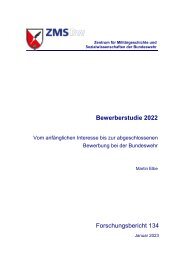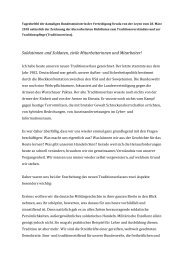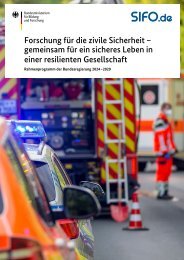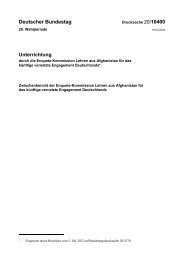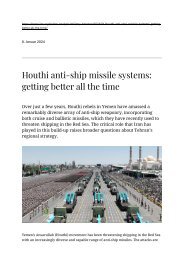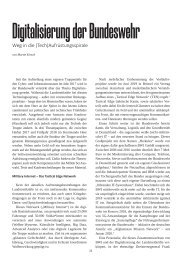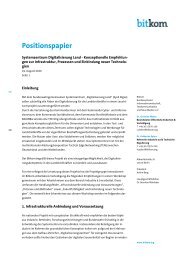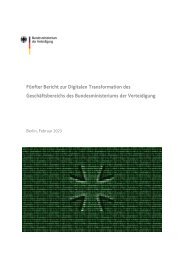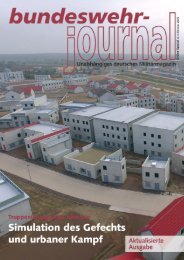EATC
Create successful ePaper yourself
Turn your PDF publications into a flip-book with our unique Google optimized e-Paper software.
damental cornerstone in building as much<br />
interoperability as possible.<br />
Study no. 28 (Employment Branch):<br />
Cross-parachuting<br />
The aim is to establish and certify procedures<br />
which enable the Ops Division to<br />
task any PN’s executing agency to drop paratroopers<br />
or conduct aerial deliveries from<br />
or for any other PN’s military user.This also<br />
includes the certification of the equipment.<br />
All <strong>EATC</strong> members want to hold an efficient<br />
airdrop capacity in the three main<br />
pillars that are the operations, the training<br />
and the sharing of a fleet.This study group<br />
manages a booklet taking up the different<br />
aspects of interoperability between the nations<br />
(certification of the parachutes, cargo<br />
crew composition during a static line drop,<br />
a matrix with the parachutes data, ...).<br />
These data are very important to prepare<br />
all types of missions and the <strong>EATC</strong> has a<br />
very good experience in conducting exercises<br />
(EAATTC, EATT, ...).<br />
The accession of Spain and Italy is a<br />
new challenge and their strong motivation<br />
to integrate the <strong>EATC</strong> structure opens up<br />
new possibilities. The second step of the<br />
study is the airdrop of material. It is already<br />
possible to exchange some containers and<br />
platforms between nations using the US procedures;<br />
we just need a document certifying<br />
that the load was inspected. It will be<br />
easier to standardize the procedures with<br />
the arrival of the Airbus A400M in several<br />
nations.The <strong>EATC</strong> sets up an interoperability<br />
week and two meetings each year.The<br />
goal is to gather the experts of each nation<br />
around a table and to certify or find a compromise<br />
about the parachutes and the procedures.Other<br />
nations and international organizations<br />
are very active in developing<br />
interoperability within NATO and the <strong>EATC</strong><br />
will be one of the keystones of the project.<br />
Currently, UK is joining our effort.<br />
FUND’s Recurrent Work<br />
When a study starts, a desired end-state is<br />
defined.This end-state can take many forms –<br />
but reaching this does not always put an<br />
end to the work related to the subject. Especially<br />
if the result of a study is a regulation<br />
or standing procedure, the work of the<br />
<strong>EATC</strong> and the nations continues and is referred<br />
to as a recurrent task.<br />
For standing procedures, this work can<br />
be regular reports to be provided to the nations.This<br />
kind of work can be easily planned<br />
as the workload – and due dates – are clearly<br />
identified. A good example is the yearly<br />
fleet review performed by the TechLog<br />
Branch of the Functional Division.<br />
As for other procedures, the responsible<br />
branch needs to react in a prescribed way to<br />
requests or actions by the nations.TREX<br />
Branch handles participation offers or requests<br />
by one nation to another nation’s<br />
exercises in this way, as described in the<br />
SOP for cross-participation.All documents<br />
published by the <strong>EATC</strong> are subject to regular<br />
reviews. These reviews are based on<br />
changes of the source and driving documents<br />
or base assumptions for a regulation.The recurring<br />
work on the <strong>EATC</strong> Flight Duty<br />
Regulation clearly reflects this.<br />
Linked to the review of regulations, the<br />
<strong>EATC</strong> is actively participating in groups that<br />
work on the source documents of existing<br />
<strong>EATC</strong> documents and procedures.Typical<br />
examples are the NATO Air Transport Working<br />
Group and different groups under the<br />
umbrella of, for example, EDA.<br />
An active role in a group can also be expanded<br />
like it is the case for the Load<br />
Clearance Working Group of the EAG,<br />
where the <strong>EATC</strong> has recently taken over<br />
the role of chairman.<br />
The examples of our recurrent work as<br />
exposed in the next paragraphs give an insight<br />
of what this work is about and are<br />
only a picture of the situation at the time<br />
of publication of this magazine (Annotation:<br />
More information can be found on the <strong>EATC</strong><br />
website www.eatc-mil.com/recurrent).<br />
Yearly Fleet Review<br />
The <strong>EATC</strong> Fleet Review, which was published<br />
in 2014 for the first time, gives a<br />
detailed overview of the <strong>EATC</strong> fleet, statistics<br />
about its usage and the expected or<br />
forecasted development. The main goal is<br />
to share information between the PNs<br />
using the same type of A/C and to provide<br />
yearly data regarding their utilization. Each<br />
type of A/C is briefly described. In addition,<br />
information can be found about the main-<br />
25



